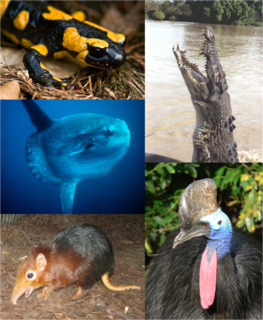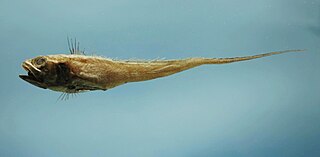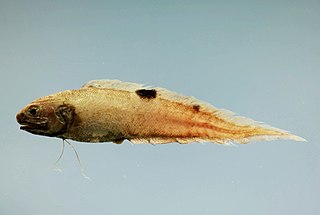
Vertebrates comprise all species of animals within the subphylum Vertebrata. Vertebrates represent the overwhelming majority of the phylum Chordata, with currently about 69,276 species described. Vertebrates include the jawless fishes and jawed vertebrates, which include the cartilaginous fishes and the bony fishes.

Crayfish, also known as crawfish, crawdads, crawlfish, crawldads, freshwater lobsters, mountain lobsters, mudbugs, or yabbies are freshwater crustaceans resembling small lobsters. Taxonomically, they are members of the superfamilies Astacoidea and Parastacoidea. They breathe through feather-like gills. Some species are found in brooks and streams where there is running fresh water, while others thrive in swamps, ditches, and paddy fields. Most crayfish cannot tolerate polluted water, although some species such as Procambarus clarkii are hardier. Crayfish feed on animals and plants, either living or decomposing, and detritus.

Sharks are a group of elasmobranch fish characterized by a cartilaginous skeleton, five to seven gill slits on the sides of the head, and pectoral fins that are not fused to the head. Modern sharks are classified within the clade Selachimorpha and are the sister group to the rays. However, the term "shark" has also been used for extinct members of the subclass Elasmobranchii outside the Selachimorpha, such as Cladoselache and Xenacanthus, as well as other Chondrichthyes such as the holocephalid eugenedontidans.

Catfish are a diverse group of ray-finned fish. Named for their prominent barbels, which resemble a cat's whiskers, catfish range in size and behavior from the three largest species alive, the Mekong giant catfish from Southeast Asia, the wels catfish of Eurasia and the piraíba of South America, to detritivores, and even to a tiny parasitic species commonly called the candiru, Vandellia cirrhosa. There are armour-plated types and there are also naked types, neither having scales. Despite their name, not all catfish have prominent barbels. Members of the Siluriformes order are defined by features of the skull and swimbladder. Catfish are of considerable commercial importance; many of the larger species are farmed or fished for food. Many of the smaller species, particularly the genus Corydoras, are important in the aquarium hobby. Many catfish are nocturnal, but others are crepuscular or diurnal.

Lake Victoria is one of the African Great Lakes. The lake was named after Queen Victoria by the explorer John Hanning Speke, the first Briton to document it. Speke accomplished this in 1858, while on an expedition with Richard Francis Burton to locate the source of the Nile River.

Tilapia is the common name for nearly a hundred species of cichlid fish from the tilapiine cichlid tribe. Tilapia are mainly freshwater fish inhabiting shallow streams, ponds, rivers, and lakes, and less commonly found living in brackish water. Historically, they have been of major importance in artisanal fishing in Africa, and they are of increasing importance in aquaculture and aquaponics. Tilapia can become a problematic invasive species in new warm-water habitats such as Australia, whether deliberately or accidentally introduced, but generally not in temperate climates due to their inability to survive in cold water.

Sturgeon is the common name for the 27 species of fish belonging to the family Acipenseridae. Their evolution dates back to the Triassic some 245 to 208 million years ago. The family is grouped into four genera: Acipenser, Huso, Scaphirhynchus and Pseudoscaphirhynchus. Four species may now be extinct. Two closely related species, Polyodon spathula and Psephurus gladius are of the same order, Acipenseriformes, but are in the family Polyodontidae and are not considered to be "true" sturgeons. Both sturgeons and paddlefish have been referred to as "primitive fishes" because their morphological characteristics have remained relatively unchanged since the earliest fossil record. Sturgeons are native to subtropical, temperate and sub-Arctic rivers, lakes and coastlines of Eurasia and North America.

"Sardine" and "pilchard" are common names used to refer to various small, oily fish in the herring family Clupeidae. The term "sardine" was first used in English during the early 15th century and may come from the Mediterranean island of Sardinia, around which sardines were once abundant.
FishBase is a global species database of fish species. It is the largest and most extensively accessed online database on adult finfish on the web. Over time it has "evolved into a dynamic and versatile ecological tool" that is widely cited in scholarly publications.

The Philippine Sea is a marginal sea east and northeast of the Philippines occupying an estimated surface area of 5 million square kilometres. The Philippine Sea Plate forms the floor of the sea, which forms a portion of the western North Pacific Ocean. It is bordered by the Philippine archipelago on the southwest; Halmahera, Morotai, Palau, Yap, and Ulithi on the southeast; the Marianas, including Guam, Saipan, and Tinian, on the east; the Bonin and Iwo Jima on the northeast; the Japanese islands of Honshu, Shikoku, and Kyūshū on the north; the Ryukyu Islands on the northwest; and Taiwan in the west.

A piranha or piraña, a member of family Characidae in order Characiformes, is a freshwater fish that inhabits South American rivers, floodplains, lakes and reservoirs. Although often described as extremely predatory and mainly feeding on fish, their dietary habits vary extensively, and they will also take plant material, leading to their classification as omnivorous. In Venezuela, they are called caribes. They are known for their sharp teeth and powerful jaws.

Macroudidae is a family of deep sea fish, a diverse and ecologically important group, which are part of the order of cod-like fish, the Gadiformes. The species in the Macrouridae are characterised by their large heads which normally have a single barbel on the chin, projecting snouts, and slender bodies that taper to whip-like tails, without an obvious caudal fin but what there is of the caudal fin is often confluent with the posterior dorsal and anal fins. There are normally two dorsal fins, the anterior dorsal fin is quite high, the posterior quite low but is longer and takes up a greater proportion of the fish's of the back, species in the subfamily Macrouroidinae have a single dorsal fin. The long anal fin is almost as long as the second dorsal fin is nearly as long as the posterior dorsal, and sometimes it is longer. The pelvic fin is inserted in the vicinity of the thorax and normally has 5-17 fin rays but are absent in Macrouroides. The body is covered in small scales and if they have a photophore, it is usually on the midline of the abdomen just in front of the anus. The bioluminescence of these fish is produced by symbiotic bioluminescent bacteria. The structure of the skull has been used to show their placing in the Gadiformes, but they differ from the typical cods in that they possess one stout spine in the anterior dorsal fin.

The cusk-eel family, Ophidiidae, is a group of marine bony fishes in the order Ophidiiformes. The scientific name is from the Greek ophis meaning "snake", and refers to their eel-like appearance. True eels, however, diverged from other ray-finned fish during the Jurassic, while cusk-eels are part of the Percomorpha clade, along with tuna, perch, seahorses, and others. Unlike true eels of the order Anguilliformes, cusk-eels have ventral fins that are developed into a forked barbel-like organ below the mouth. In the true eels by contrast, the ventral fins are never well-developed and usually missing entirely.

Fish are gill-bearing aquatic craniate animals that lack limbs with digits. They form a sister group to the tunicates, together forming the olfactores. Included in this definition are the living hagfish, lampreys, and cartilaginous and bony fish as well as various extinct related groups. Tetrapods emerged within lobe-finned fishes, so cladistically they are fish as well. However, traditionally fish are rendered paraphyletic by excluding the tetrapods. Because in this manner the term "fish" is defined negatively as a paraphyletic group, it is not considered a formal taxonomic grouping in systematic biology, unless it is used in the cladistic sense, including tetrapods. The traditional term pisces is considered a typological, but not a phylogenetic classification.
Dicrolene is a genus of cusk-eels.

Cichliformes is an order of fishes, previously classifies under the order Perciformes but now many authorities consider it to be an order within the subseries Ovalentaria.

Neobythitinae is a subfamily of cusk eel from the family Ophidiidae. They are mostly fishes of deeper waters, occurring from the continental shelf down to as deep as 8,370 metres (27,460 ft) at the bottom of the Puerto Rico trench where the deepest known fish, Abyssobrotula galatheae, has been taken.

Oxudercidae is a family of gobies which was consists of four subfamilies which were formerly classified under the family Gobiidae. The family is sometimes called the Gobionellidae, but Oxudercidae has priority. The species in this family have a cosmopolitan distribution in temperate and tropical areas and are found in marine and freshwater environments, typically in inshore, euryhaline areas with silt and sand substrates.

Goby is a common name for many species of small to medium sized ray-finned fish, normally with large heads and tapered bodies, which are found in marine, brackish and freshwater environments. Traditionally most of the species called gobies have been classified in the order Perciformes as the suborder Gobioidei but in the 5th Edition of Fishes of the World this suborder is elevated to an order Gobiiformes within the clade Percomorpha. Not all the species in the Gobiiformes are referred to as gobies and the "true gobies" are placed in the family Gobiidae, while other species referred to as gobies have been placed in the Oxudercidae.. Goby is also used to describe some species which are not classified within the order Gobiiformes, such as the engineer goby or convict blenny Pholidichthys leucotaenia. The word goby derives from the Latin gobius meaning "gudgeon", and some species of goby, especially the sleeper gobies in the family Eleotridae and some of the dartfishes are called "gudgeons", especially in Australia.

















